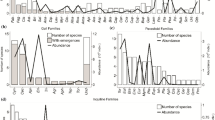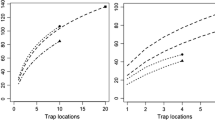Abstract
We compared the parasitoid communities associated with grass-feeding herbivores in Germany and Britain to examine geographical consistency in community composition and to test ecological characteristics of the plants and host insects that may explain variability in parasitoid community structure. The parasitoid communities of 16 chalcid wasps feeding on ten grass species were sampled between 1986 and 1989 at 4–11 sites per grass species in southwest Germany. The data were compared to published data from Great Britain, comprising 18 chalcid hosts on ten grass species sampled between 1980 and 1992 at 24 sites in Wales and England. Results showed that many conclusions drawn from patterns in Britain did not hold for Germany, emphasizing the need to repeat analyses in different geographical regions. The parasitoid communities of the Tetramesa hosts included on average 8.1 parasitoid species in Germany, while the British hosts supported only 4.1 parasitoids. The number of monophagous parasitoid species was similar in both areas (2.4 vs 3.2), but German host populations supported many more polyphagous species (5.1 vs 0.9). This difference reinforces the earlier conclusion that parasitoid communities in Britain are highly undersaturated. Increased numbers of parasitoid species in Germany did not result in increased parasitism rates, so the closer species packing was paralleled by reduced impact of each species. In Germany, percent parasitism (range: 5–74%) was closely correlated with log host density, explaining 90% of the variance, while in Great Britain, percent parasitism was less variable (range: 36–76%) and was not related to host density or other host or host plant characteristics. Gallers and non-gallers supported equal numbers of parasitoids in both Germany and Britain, offering support for neither the enemy hypothesis of the adaptive nature of plant galls nor for the finding that galls are often more susceptible to enemy attack than their non-galling relatives. Furthermore, gregarious Tetramesa hosts were not attacked by more parasitoid species than solitary hosts.
Similar content being viewed by others
Author information
Authors and Affiliations
Additional information
Electronic Publication
Rights and permissions
About this article
Cite this article
Tscharntke, T., Vidal, S. & Hawkins, B.A. Parasitoids of grass-feeding chalcid wasps: a comparison of German and British communities. Oecologia 129, 445–451 (2001). https://doi.org/10.1007/s004420100733
Received:
Accepted:
Published:
Issue Date:
DOI: https://doi.org/10.1007/s004420100733




